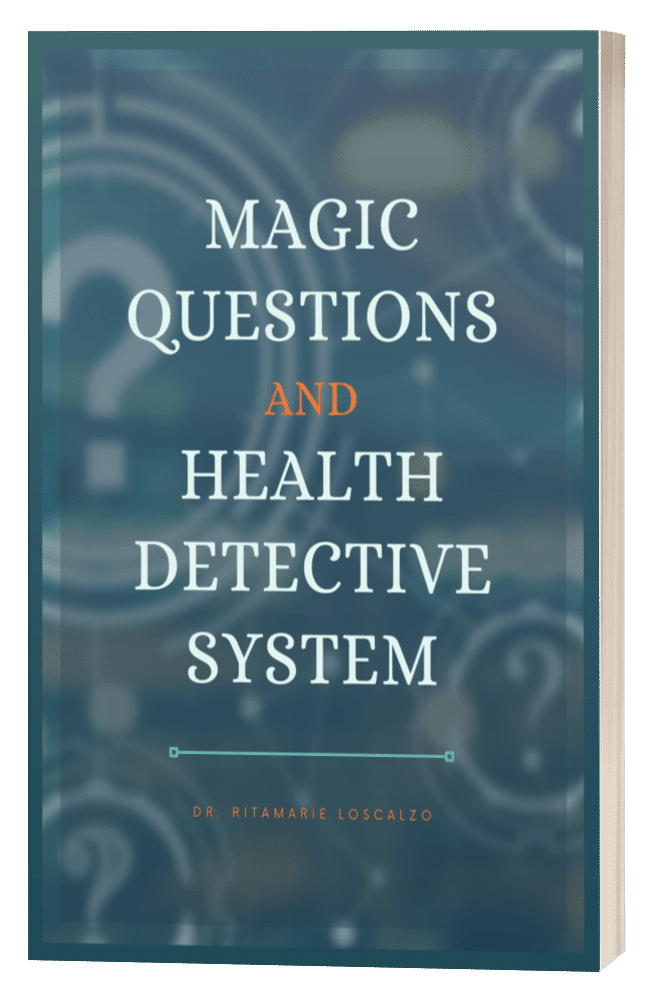HOME > adrenal fatigue > What is Insulin Resistance? 5 Stealth Causes That Have Nothing to Do with Diet and Exercise
What is Insulin Resistance? 5 Stealth Causes That Have Nothing to Do with Diet and Exercise
By Ritamarie Loscalzo

In my practice, insulin resistance contributes to over 50% of cases. The symptoms can be all over the map, so most people don’t even know they have blood sugar imbalances. Some of the sneaky symptoms are:
- Hormone imbalances, such as hot flashes, infertility, and PMS1
- Food cravings or excessive appetite
- Fatigue due to reactive hypoglycemia, especially after a high-carbohydrate meal
- Stubborn body fat, especially in the belly2
- Mood swings and mental health issues such as depression3
- Brain fog, inability to focus and poor memory
What is Insulin Resistance?
Insulin is a hormone produced by beta cells in the pancreas. Insulin opens the door for glucose to enter your cells by making the protein called glucose transporter type 4 (GLUT4) more available on the surface of muscle, brain, and fat cells. High blood glucose stimulates beta cells to release more insulin in order to store glucose in tissues that have GLUT44,5.
“Insulin resistance” is caused by too high blood sugar and thus too much insulin over a long period of time. Eventually, your cells stop responding to insulin and reduce GLUT4 on the cell surface6,7. While we may associate insulin with carbohydrates, overeating can also cause our cells to become insulin resistant8.
Insulin resistance demands beta cells to produce more and more insulin. When the beta cells start to burn out and die from overworking, that’s when it has progressed to type II diabetes8. In addition, high blood sugar and insulin resistance create oxidative stress and inflammation, which can contribute to premature aging, Alzheimer’s disease, heart disease, high blood pressure, and cancers9-11.
Five Hidden Causes of Insulin Resistance
While we might associate insulin resistance with sugar or overeating, many modern lifestyle factors also cause insulin resistance. This may explain the paradox that many overweight and diabetic people are not seeing results from the conventional advice to “eat less and exercise more.”
Diabetogenic Hormone disruptors
It might seem “normal” to lather on the floral-scented soap and shampoo in the shower, then apply your favorite lotions and creams, and put on makeup and perfume before you go to work. Unbeknownst to you, by the time you get out the door, you could already be exposed to 515 different hormone disruptors from these products12! And babies are now born with over 287 of them in their cord blood13.
Almost anything made by any modern industry can contain them14. These include parabens in most personal care products, plastic residues like BPA, flame retardants on your furniture, heavy metals and dioxins in car exhausts, mold toxins, and pesticides.
Hormone disruptors not only cause your canonical hormonal problems, such as causing estrogen dominance, but they can also mess with insulin function so much that they are dubbed “diabetogens”15!
Hormone disruptors can impair insulin production and cause insulin resistance at the same time. In addition, they can increase appetite and put you in fat-storage mode, making it difficult to lose weight14. They also cause chronic low-grade inflammation that worsens insulin resistance and contribute to all modern diseases16.
Fortunately, we now have options for many hormone disruptor-free personal care products, food packaging, and furniture. However, everyone is still exposed to pollution to some extent, so regular detoxification is important to maintain health.
Circadian rhythm dysregulation
Beyond sleep, your body clock also controls appetite, energy expenditure, nutrient uptake and insulin sensitivity17,18. Naturally, sunlight during the day and darkness at night are the most important cues that tell your body what time it is.
Most people nowadays have artificial bright lights on at night or look at screens until they fall asleep. These lights, especially the blue spectrum, can trick your body to think that it is daytime and block the release of night hormones. In addition, shift work and our tendency to stay up later than optimal also cause circadian rhythm dysregulation. Unhealthy circadian rhythm can directly cause insulin resistance19,20.
To restore optimal blood sugar balance, it is important to optimize your circadian rhythm. These include using blue blockers and dimming your lights at night.
Sleep problems
Very few people are getting enough sleep nowadays! In the 1960s, adults slept on average over 8 hours per night. Now, the average is closer to 6.5 hours21.
One night of sleep deprivation is enough to cause insulin resistance in otherwise healthy adults22, and things only get worse with chronic sleep deprivation23,24. It is very hard to balance your blood sugar if you are not sleeping well.
Not all sleep is created equal. Good quality sleep means uninterrupted sleep that allows you to reach all the restorative sleep stages24. Many people, especially the overweight, have disrupted sleep due to sleep disorders such as sleep apnea and good old insomnia21. If left untreated, poor sleep quality will throw off blood sugar25,26.
Sleep disorders are more common than you think. About 1 in 4 Americans suffer from a sleep disorder, and less than 10% of the cases are diagnosed and treated27. If you wake up unrested and still have stubborn insulin resistance despite pulling all stops to optimize your sleep, consider seeing a sleep doctor to rule out sleep disorders.
Stress
Stress is such a significant part of the modern lifestyle. Work, traffic, family, and even how we spend our free time can cause stress in our bodies.
Our bodies are made to deal with stress physically. When we are stressed, the pituitary and adrenal glands release the stress hormones cortisol and adrenaline. These hormones increase blood sugar to prepare us to fight or flight. However, because modern stress typically doesn’t require us to move, we often bottle up the stress and our blood sugar remains high. If we don’t learn to deal with stress hormones productively, such as by exercising, it can lead to insulin resistance28-30.
In addition, unresolved psychological stress and trauma can drive insulin resistance, inflammation, and weight gain31,32.
Chronic low-grade inflammation
Chronic low-grade inflammation can directly cause insulin and leptin resistance33. Inflammatory molecules can block insulin function and reduce the number of GLUT4 receptors in muscle and fat tissues34. People who struggle with insulin resistance typically have some chronic inflammation going on, which could be from unhealthy diets, leaky gut, toxic exposures, obesity, and infections. In order to balance your blood sugar, it is important to address these sources of inflammation.
Scientific evidence has clearly shown that diabetogenic chemicals, artificial lights, poor sleep, stress, and inflammation drive insulin resistance and obesity. This is why people remain sick and can’t lose weight despite eating less and exercising more.
In order to fully reverse insulin resistance, it is important to address these five lifestyle factors. In my Sweet Spot Solution program, I educate about these factors and provide step-by-step instructions to implement a blood-sugar balancing lifestyle. To get a sneak peak of the program and the kind of meal plans you can follow, check out my free Plant-Based Keto Recipe Guide.
References:
1. Thurston, R. C. et al. Vasomotor symptoms and insulin resistance in the study of women’s health across the nation. J. Clin. Endocrinol. Metab. 97, 3487–3494 (2012).
2. Westergren, H., Danielsson, A., Nystrom, F. H. & Strålfors, P. Glucose transport is equally sensitive to insulin stimulation, but basal and insulin-stimulated transport is higher, in human omental compared with subcutaneous adipocytes. Metabolism. 54, 781–785 (2005).
3. Timonen, M. et al. Insulin resistance and depression: cross sectional study. BMJ 330, 17–18 (2005).
4. Fukumoto, H. et al. Cloning and characterization of the major insulin-responsive glucose transporter expressed in human skeletal muscle and other insulin-responsive tissues. J. Biol. Chem. 264, 7776–7779 (1989).
5. Niures, M., Matioli, P. S. & Nitrini, R. Mechanisms linking brain insulin resistance to Alzheimer’s disease. Dementia & Neuropsychologia, Association of Cognitive and Behavioral Neurology https://www.ncbi.nlm.nih.gov/pmc/articles/PMC5619347/ (2015).
6. Mueckler, M. Insulin resistance and the disruption of glut4 trafficking in skeletal muscle. Journal of Clinical Investigation vol. 107 1211–1213 (2001).
7. Gaster, M., Staehr, P., Beck-Nielsen, H., Schrøder, H. D. & Handberg, A. GLUT4 is reduced in slow muscle fibers of type 2 diabetic patients: Is insulin resistance in type 2 diabetes a slow, type 1 fiber disease? Diabetes 50, 1324–1329 (2001).
8. Muoio, D. M. & Newgard, C. B. Mechanisms of disease: Molecular and metabolic mechanisms of insulin resistance and ?-cell failure in type 2 diabetes. Nature Reviews Molecular Cell Biology vol. 9 193–205 (2008).
9. Avogaro, A., De Kreutzenberg, S. V., Federici, M. & Fadini, G. P. The endothelium abridges insulin resistance to premature aging. J. Am. Heart Assoc. 2, (2013).
10. Ferreira, L. S. S., Fernandes, C. S., Vieira, M. N. N. & De Felice, F. G. Insulin resistance in Alzheimer’s disease. Frontiers in Neuroscience vol. 12 (2018).
11. Orgel, E. & Mittelman, S. D. The links between insulin resistance, diabetes, and cancer. Curr. Diab. Rep. 13, 213–222 (2013).
12. Huff, E. Toxic Burden: Women Put 515 Chemicals on Their Faces Every Day. Organic Consumers Association (2009).
13. Ünüvar, T. & Büyükgebiz, A. Fetal and neonatal endocrine disruptors. JCRPE Journal of Clinical Research in Pediatric Endocrinology vol. 4 51–60 (2012).
14. Gibert, Y. et al. Endocrine Disrupting Chemicals: An Occult Mediator of Metabolic Disease. Front. Endocrinol. 1, 112 (2019).
15. Fénichel, P. & Chevalier, N. Environmental endocrine disruptors: New diabetogens? Comptes Rendus – Biologies vol. 340 446–452 (2017).
16. Petrakis, D. et al. Endocrine disruptors leading to obesity and related diseases. International Journal of Environmental Research and Public Health vol. 14 (2017).
17. Boden, G., Ruiz, J., Urbain, J. L. & Chen, X. Evidence for a circadian rhythm of insulin secretion. Am. J. Physiol. – Endocrinol. Metab. 271, (1996).
18. Kitazawa, M. Circadian rhythms, metabolism, and insulin sensitivity: Transcriptional networks in animal models. Current Diabetes Reports vol. 13 223–228 (2013).
19. Stenvers, D. J., Scheer, F. A. J. L., Schrauwen, P., la Fleur, S. E. & Kalsbeek, A. Circadian clocks and insulin resistance. Nature Reviews Endocrinology vol. 15 75–89 (2019).
20. Schwartsburd, P. M. Catabolic and anabolic faces of insulin resistance and their disorders: A new insight into circadian control of metabolic disorders leading to diabetes. Futur. Sci. OA 3, (2017).
21. Mesarwi, O., Polak, J., Jun, J. & Polotsky, V. Y. Sleep Disorders and the Development of Insulin Resistance and Obesity. Endocrinology and Metabolism Clinics of North America vol. 42 617–634 (2013).
22. Donga, E. et al. A single night of partial sleep deprivation induces insulin resistance in multiple metabolic pathways in healthy subjects. J. Clin. Endocrinol. Metab. 95, 2963–2968 (2010).
23. Spiegel, K., Knutson, K., Leproult, R., Tasali, E. & Van Cauter, E. Sleep loss: A novel risk factor for insulin resistance and Type 2 diabetes. Journal of Applied Physiology vol. 99 2008–2019 (2005).
24. Reutrakul, S. & Van Cauter, E. Sleep influences on obesity, insulin resistance, and risk of type 2 diabetes. Metabolism: Clinical and Experimental vol. 84 56–66 (2018).
25. Barceló, A. et al. Insulin resistance and daytime sleepiness in patients with sleep apnoea. Thorax 63, 946–950 (2008).
26. IP, M. S. M. et al. Obstructive Sleep Apnea Is Independently Associated with Insulin Resistance. Am. J. Respir. Crit. Care Med. 165, 670–676 (2002).
27. Cleveland Clinic. Sleep Disorders. Cleveland Clinic (2013).
28. Li, L., Li, X., Zhou, W. & Messina, J. L. Acute psychological stress results in the rapid development of insulin resistance. J. Endocrinol. 217, 175–184 (2013).
29. Faulenbach, M. et al. Effect of psychological stress on glucose control in patients with Type 2 diabetes. Diabet. Med. 29, 128–131 (2012).
30. Yan, Y. X. et al. Investigation of the relationship between chronic stress and insulin resistance in a Chinese population. J. Epidemiol. 26, 355–360 (2016).
31. Farrell, K. & Antoni, M. H. Insulin resistance, obesity, inflammation, and depression in polycystic ovary syndrome: Biobehavioral mechanisms and interventions. Fertil. Steril. 94, 1565–1574 (2010).
32. Nasca, C. et al. Childhood trauma and insulin resistance in patients suffering from depressive disorders. Exp. Neurol. 315, 15–20 (2019).
33. Martin, S. S., Qasim, A. & Reilly, M. P. Leptin Resistance. A Possible Interface of Inflammation and Metabolism in Obesity-Related Cardiovascular Disease. Journal of the American College of Cardiology vol. 52 1201–1210 (2008).
34. Chen, L., Chen, R., Wang, H. & Liang, F. Mechanisms Linking Inflammation to Insulin Resistance. International Journal of Endocrinology vol. 2015 (2015).
Share this:

Are you feeling stuck?
Do you feel as if something is missing from your practice that's keeping you from delivering breakthrough outcomes for your clients?.
Recent Posts
Our Programs
Nutritional Endocrinology Practitioner Training (NEPT)
The Mastery and Certification tier is our flagship program and provides everything you need to feel confident as a practitioner who knows how to get results that lead to healthy and happy clients.
Functional Assessment Mastery
Explore the relationships between the most important hormones and their relationship with nutrition.
Functional Nutrition Mastery
Learn how to support your clients to eat and supplement in a way that reduces and eliminates chronic symptoms.
Medical Disclaimer: The information on this website is not intended to replace a one-on-one relationship with a qualified health care professional and is not intended as medical advice. It is intended as a sharing of knowledge and information from the research and experience of Dr. Ritamarie Loscalzo, drritamarie.com, and the experts who have contributed. We encourage you to make your own health care decisions based upon your research and in partnership with a qualified health care professional.
Disclosure: Sometimes (but not always), when I share resources in my programs, newsletter, and on my website, I'm using an affiliate link, which means I do make money if you buy. My credibility is extremely important to me; therefore, I only endorse the products, services, and people I believe in. DrRitamarie.com is independently owned and the opinions expressed here are my own.
Click here to see our Privacy Policy.










